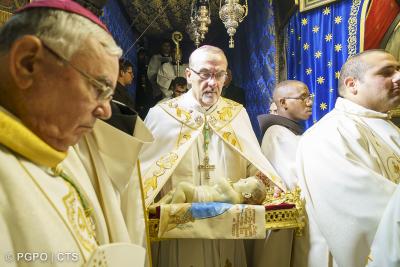The solemnity eagerly awaited by the whole of the Christian world, Christmas Eve, was this year again celebrated in Bethlehem, culminating in the nocturnal mass of the Nativity of Our Lord Jesus Christ, in the presence of numerous pilgrims, faithful and religious who wanted to be in his birthplace. The celebrations were presided by the Latin Patriarch His Beatitude Pierbattista Pizzaballa.
In the morning, at the seat of the Latin Patriarchate of Jerusalem, Mons. Pizzaballa received Fr. Amjad Sabbara, parish priest of the Latin church of Jerusalem together with the local community of St Saviour. From there he went in a procession towards Bethlehem; as tradition has it, on the way, it stopped in front of the Greek Orthodox monastery of Mar Elias and in front of Rachel’s Tomb, to meet the local civic and religious authorities. After having crossed the wall of separation between the Israeli and Palestinian territories, the Patriarch and the procession then went towards Bethlehem.
A huge crowd awaited in front of the Basilica of the Nativity, in spite of the rain that did not discourage the jubilant families and young people: the Patriarch crossed Star Street on foot, accompanied by the Vicar of the Custody of the Hoy Land, fr. Ibrahim Faltas and preceded by many groups of local scouts who with their drums and bagpipes paraded along the street. In the large Manger Square, His Beatitude Pizzaballa was welcomed by the Mayor of Bethlehem Anton Salman and then, in front of the Basilica of the Nativity, by fr. Enrique Segovia, guardian of the Franciscan convent of Bethlehem, and by the representatives of the Greek Orthodox and Armenian communities who, together with the Franciscans, look after the Basilica.
The First Vespers, celebrated in St Catherine’s church, and the procession to the Grotto of the Nativity, mark the official start of the liturgical solemnity of the Nativity. Before the Mass of Christmas Eve, at 7.00 p.m. local time, there was the dinner which was attended by the Patriarch and the Custos of the Holy Land fr. Francesco Patton, the President of the Palestinian Authority Maḥmūd ʿAbbās, the canonists of the Patriarch and other civil and military authorities.
At midnight, in a church where a crowd was anxiously waiting, the eucharistic celebration began, presided by the Patriarch and in the presence of the General Consuls of Spain, Italy, France and Belgium, the four nations defined Catholic, while a mega screen set up in the square allowed all the faithful who were outside the Basilica to follow the Mass. The song of the Gloria echoed solemnly and joyfully, to proclaim the birth of Jesus and in praise of God.
During the homily, the Patriarch wanted to recall the situations of war and abuse that are troubling the world today: “With our eyes we see that violence seems to have become our main language, the way we communicate.” “In these contexts which are so torn and hurt,” His Beatitude Pizzaballa continued, “the first and most important vocation of our Church is to help looking at the world with the heart as well, and to recall that life has meaning only if we open up to love. Celebrating Christmas for us, the community of believers in Christ, means creating, promoting and being an occasion for mercy, compassion and forgiveness. It means bringing into the life of our distressed context that Desire full of compassion that God manifested with the birth of Jesus.”
After Mass, the statue of the Child Jesus was brought from St Catherine’s church in a procession into the Grotto of the Nativity, and the Latin Patriarch placed it where, according to tradition, the manger had been: as then, Jesus is born today for the salvation of humanity. “Do not be afraid: for I proclaim to you good news of great joy that will be for all the people; today, in the city of David, a Saviour has been born for you who is Messiah and Lord. And this will be a sign for you: you will find an infant wrapped in swaddling clothes and lying in a manger.” The words of the Gospel according to Luke echo here, on Christmas night, and above all in the Grotto of the Nativity, which contains the altar of the manger. Masses in small groups follow on one another on the altar until four in the afternoon of Christmas Day, like continuous praise on the birthplace of the Saviour. The Custos of the Holy Land, Fr. Francesco Patton was the first to celebrate the mass “in the place where the Son of God became flesh in the night of the world, in the darkness of our human misery, to restore to us a human face.”
By Silvia Giuliano | Custodia






